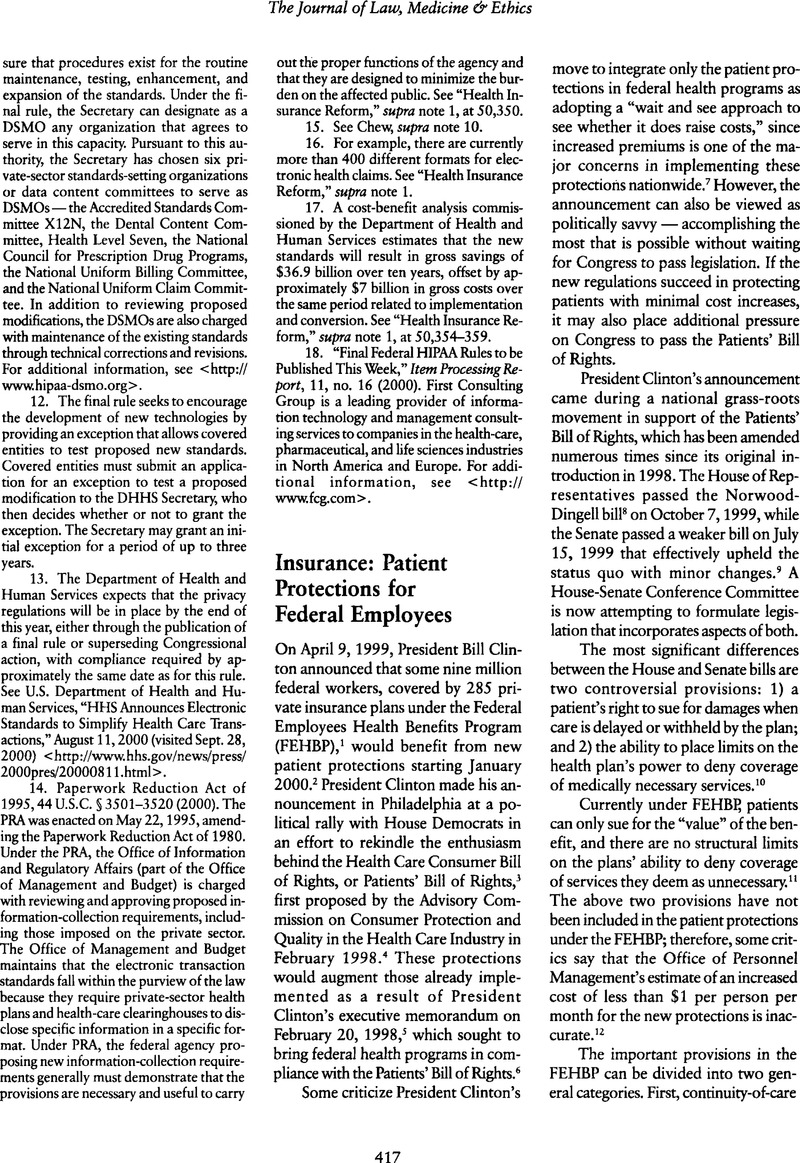No CrossRef data available.
Article contents
Insurance: Patient Protections for Federal Employees
Published online by Cambridge University Press: 01 January 2021
Abstract
An abstract is not available for this content so a preview has been provided. Please use the Get access link above for information on how to access this content.

- Type
- Article
- Information
- Copyright
- Copyright © American Society of Law, Medicine and Ethics 2000
References
The FEHBP was created through an Act in Congress in 1959 and began to provide health benefits to federal employees in July 1960. See “Federal Employees Health Benefits Program” (visited December 17, 2000) <http://www.opm.gov/insure/health>..>Google Scholar
See “Patient Protections: Clinton Announces New Patient Protections for FEHBP, Pushes Managed Care Proposal,” BNA's Health Law Reporter, 8 (April 15, 1999): At 613 [hereinafter cited as “Patient Protections”].Google Scholar
See “Quality Assurance: Clinton Orders Federal Health Programs to Comply With ‘Consumer Bill of Rights,’” BNA's Health Law Reporter, 7 (February 26, 1998): At 337 [hereinafter cited as “Quality Assurance”].Google Scholar
The Advisory Commission on Consumer Protection and Quality in the Health Care Industry was created by President Clinton to advise him about the current issues and trends in health care.Google Scholar
See “White House Electronic Publications” (visited Dec. 17, 2000) <http://www.pub.whitehouse.gov/retrieve-documents.html>..>Google Scholar
See “Quality Assurance,” supra note 3, at 337.Google Scholar
The Norwood-Dingell bill was drafted by House Representative Charlie Norwood (R-GA) and Representative Dingell (D-MI), the ranking Democrat on the Commerce Committee responsible for the bill. See “Whither the Patients' Bill of Rights?,” asap! Update, July 2000 (visited December 16, 2000) <http://www.familiesusa.org/asap/up720pbr.htm>..' href=https://scholar.google.com/scholar?q=The+Norwood-Dingell+bill+was+drafted+by+House+Representative+Charlie+Norwood+(R-GA)+and+Representative+Dingell+(D-MI),+the+ranking+Democrat+on+the+Commerce+Committee+responsible+for+the+bill.+See+“Whither+the+Patients'+Bill+of+Rights?,”+asap!+Update,+July+2000+(visited+December+16,+2000)+.>Google Scholar
See “Patient Protections,” supra note 2, at 613.Google Scholar
See id.Google Scholar
“Self-insured” plans are those where the employer assumes the cost of its employees' claims and bears all financial risk. See “The 106th Congress: How Federal Managed Care Legislation Affects You: A Comparison of Key Provisions in the Senate and House Bills on Managed Care” (visited December 17, 2000) <http://www.familiesusa.org/managedcare+u/compare2.htm>..' href=https://scholar.google.com/scholar?q=“Self-insured”+plans+are+those+where+the+employer+assumes+the+cost+of+its+employees'+claims+and+bears+all+financial+risk.+See+“The+106th+Congress:+How+Federal+Managed+Care+Legislation+Affects+You:+A+Comparison+of+Key+Provisions+in+the+Senate+and+House+Bills+on+Managed+Care”+(visited+December+17,+2000)+.>Google Scholar
See “Patient Protections,” supra note 2, at 613.Google Scholar
The “prudent layperson” standard is used to determine the level of health care “a person with average knowledge of health and medicine” can reasonably expect. See “Quality Assurance,” supra note 3, at 337.Google Scholar
See “Patient Protections,” supra note 2, at 613.Google Scholar


